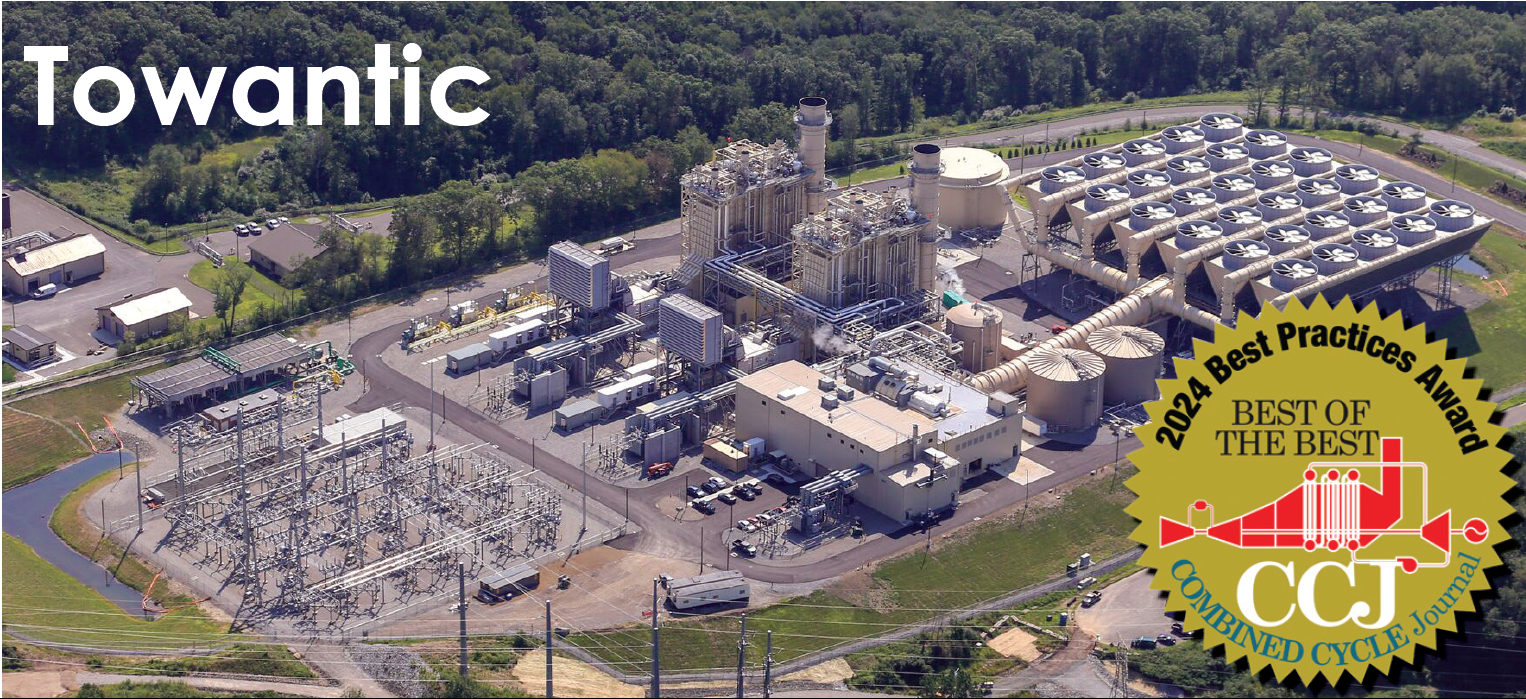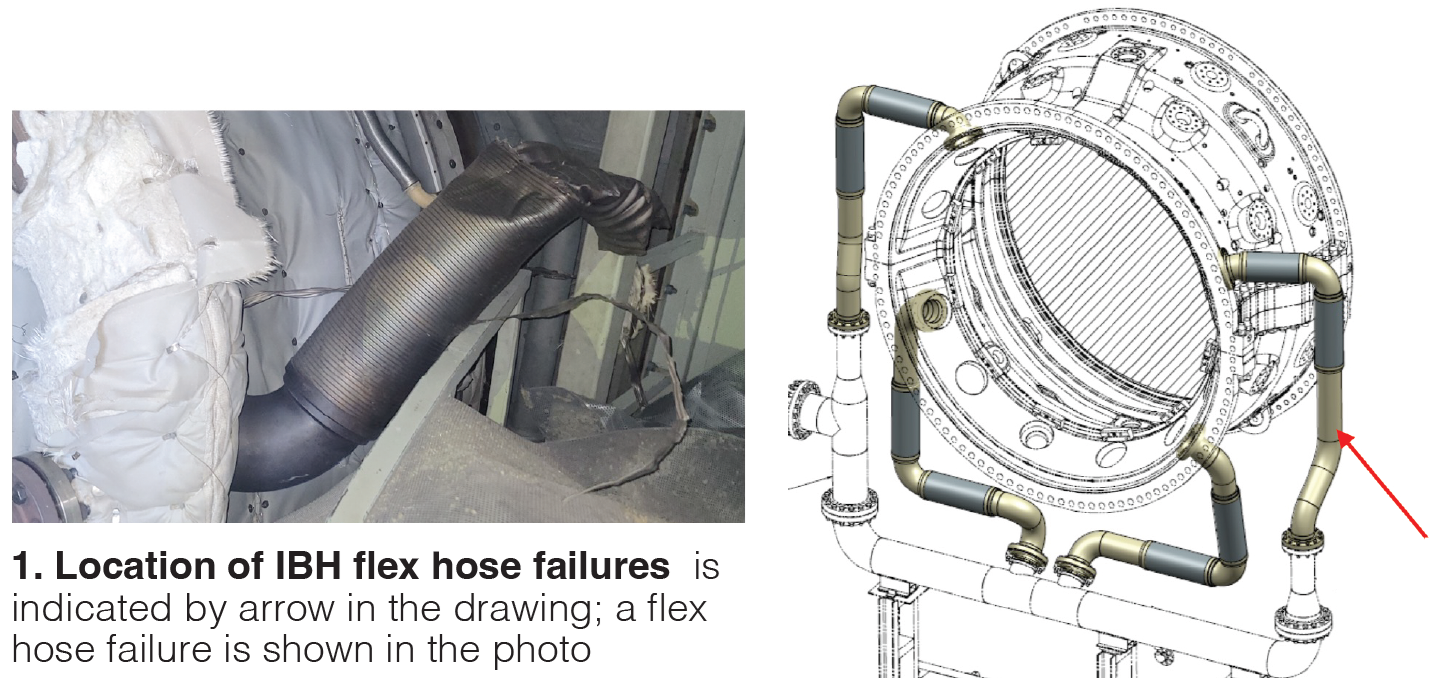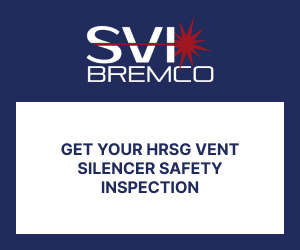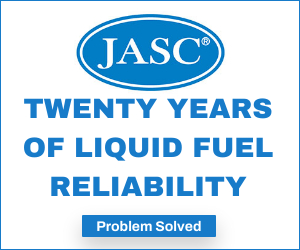
CPV Towantic Energy Center
Owned by Competitive Power Ventures and Osaka Gas
Operated by NAES Corp
805 MW, gas-fired 2 × 1 7HA.01-powered combined cycle equipped with DLN2.6+ AFS combustion systems, GE D602 steamer, and John Cockerill (formerly CMI) HRSGs, located in Oxford, Conn
Plant manager: Larry Hawk
GT enclosure cameras critical to plant’s participation in dual-fuel market
Background. CPV Towantic is an outdoor facility with two 7HA.01 gas turbines and one D602 steam turbine. The OEM released TIL-2299 in response to the 7HA inlet bleed heat (IBH) flexible-metal-hose failures experienced by some users while operating baseload (Fig 1). Hot compressor discharge air leakage from the failed flex hoses pressurized the gas-turbine enclosure and caused compartment doors to open.

To remedy this, GE released TIL-2299-R1 to communicate the availability of an improved “dog-legged” style flex hose to address torsional stress caused by the original hose configuration. Another IBH flex hose event was reported with the improved dog-leg design and the root cause analysis of determining the factors associated with that failure were still under way when this best practice was submitted to CCJ.
Challenge. TIL-2299-R2 recommends a “15-ft exclusion zone around turbine enclosure doors to keep personnel at a safe distance in the event of unexpected turbine operation.” This prohibited operators from running on No. 2 diesel fuel oil if need be. Reason: There was no way to inspect for leaking fuel oil at the combustor locations inside the compartment. Plus, it prohibited the plant from taking advantage of a lucrative market that the site was designed to compete in.
Solution. Cameras to provide visual access to the combustors was the solution favored by plant personnel. Coincidentally, Towantic already had under contract a new security partner to install site-wide cameras, badge readers, and remote visuals. However, an obstacle to this solution was a very short turnaround time of about 3.5 weeks to procure and install the equipment—without the ability to provide a good walk-down of the enclosures.
Equipment had to be run in rigid conduit and hermetically sealed according to plant specifications. The security vendor was able to procure eight Axis P1468-XLE explosion-protected bullet cameras with zoom capability that allowed 4K vision under any light conditions.
The security vendor and the site’s electrical contractor partnered to complete installation of conduit and cameras inside the GT compartments within the short outage window provided. Four cameras were installed in each GT compartment—one in each quadrant allowing visual access to the combustors (Fig 2). Shortly afterwards all the exterior equipment was run, and data links provided, to send visuals to the control room and staff computers.

Results. Towantic has eliminated the hazards and risks to personnel while operating on liquid fuel. GT enclosure cameras allow operators to use the CTs to their full potential and participate in the dual-fuel market.
Project participants:
Plant O&M personnel
Operator requalification focus of continued education program
Challenge. During commissioning, CPV Towantic plant operators completed initial qualification cards to demonstrate the necessary site-specific knowledge to work as an auxiliary operator or control room operator.
With no requalification program in place, there was no way to ensure the operators would stay knowledgeable on the systems they interact with daily. Seven years after COD, plant management wanted to ensure the knowledge received in 2017 wasn’t getting lost in the normal day-to-day site activities. This was a concern echoed by insurance carriers.
Solution. Plant management reviewed the qualification program in place, which focused on initial qualifications, and set out to find a solution to maintain site knowledge through a requalification program. The site team looked for a solution within NAES corporate and other facilities that had addressed operator requalification. It didn’t want to have the operators complete the same qualifications they initially performed because of the time involved; rather it wanted to introduce a program that had enough substance to refamiliarize the team with information useful in their work environment.
Management worked with the operations team and the union to create a program that addresses all of management’s concerns, can be done on shift without jeopardizing operations, and is built to continue operator training for the foreseeable future.
Working with NAES corporate and using some other sites’ methodologies, management was able to identify technical training courses available in the computer-based program GPiLEARN+ used for some of the plant’s safety training. In addition to the courses already available on GPiLEARN+, staff wrote 22 exams covering each system at Towantic Energy Center that can be completed on that platform. Working with corporate, plant personnel created a learning plan involving the computer-based training courses and exams that are broken down to auxiliary operators and control room operators.
Monthly, for a period of two years, operators complete the training courses assigned. When that program is finished, two years of training are completed. The training cycle then starts over and is completed again. Training procedures were updated to include the new requalification section.
Results. Continuous plant-level training is important to ensure operators retain the tools and knowledge to complete their work effectively. With the requalification program, operators review the skills required, and the resources available, to perform their daily tasks to best respond to upsets that may occur.
With the new requalification program in place, the management team continues its efforts to revise and modify requalification training to remain current on the systems in place at Towantic Energy Center.
Project participants:
NAES corporate staff and plant O&M personnel
QR coding enables fast, easy access to Towantic’s SDS library
Challenge. With approximately 200 chemicals located onsite, maintaining and using the physical SDS binders became a time, paperwork, and organizational challenge. There’s the issue of how to organize the binder, how to incorporate new SDSs, how to maintain the most current SDSs on file, and how to use the SDS binders to find pertinent information promptly.
Another challenge: To access the SDS binders, one must travel to a location where they are stored to access the information. This can add time to the response of a spill or inadvertent contact.
Solution. The site had two SDS libraries that filled two 3-in. binders located at both the entrance of the administrative building and the control room. Towantic personnel conducted a full audit of all chemicals onsite to ensure there were SDSs available and that they were current. Staff found that the amount of time it took to coordinate this effort was excessive given that two sets of SDS binders required updating.
Once the chemicals were inventoried and the SDSs updated to their most recent revisions, staff began the process of organizing the binders and realized yet another 3-in. binder was required to accommodate all the SDSs onsite. In addition to updating the binders, the SDSs were uploaded to the online “eBinder” to have a third location for all the SDSs onsite. Using eBinder, personnel are able to load any SDS to a site-specific library.
When staff realized they now had three binders of SDSs to keep updated in two different locations, personnel wondered if there was a way to make the eBinder accessible to all to make the process of using the SDS libraries faster and easier to maintain.

Using a QR code that linked to the site-specific eBinder was an effective way to access all the SDSs for the site and made searching for an SDS easier than using the hard-copy binders (Fig 3). The control room still has a physical copy that is sorted alphabetically, but when you’re searching for a chemical, you might not know the vendor’s name for it and finding it can take considerable time away from the work necessary. Using the QR code and doing a search in the library takes seconds and you can access any of the SDSs on file quickly and from anywhere onsite.
Having one QR code, staff made signs to post at multiple locations around the site, in particular where you may encounter a chemical or substance you may need an SDS for.
Results. The SDS library of all chemicals onsite is available for any employee or contractor at any time, thereby reducing the time needed to access the information required. Whether the need for the SDS is for disposal considerations, to respond to an emergency, or for general information purposes, it’s now much easier to get the information needed.
Not having two separate locations saves staff time in organizing and updating the libraries. While the plant still has one physical copy, maintaining it takes half the time as it did before.
Project participants:
Plant O&M personnel









